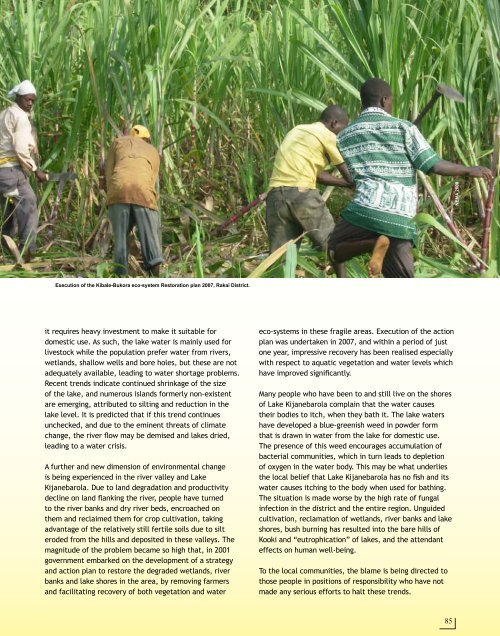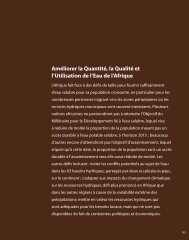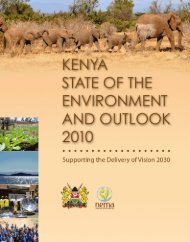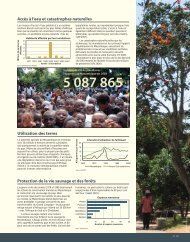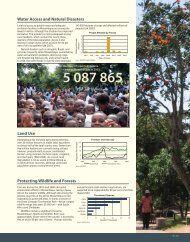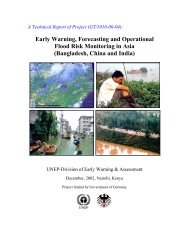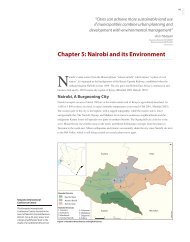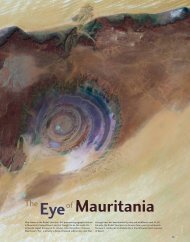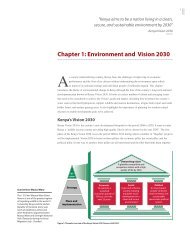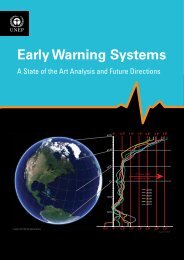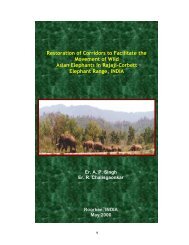Uganda Atlas of Our Changing Environment - GRID-Arendal
Uganda Atlas of Our Changing Environment - GRID-Arendal
Uganda Atlas of Our Changing Environment - GRID-Arendal
Create successful ePaper yourself
Turn your PDF publications into a flip-book with our unique Google optimized e-Paper software.
Execution <strong>of</strong> the Kibale-Bukora eco-system Restoration plan 2007, Rakai District.<br />
it requires heavy investment to make it suitable for<br />
domestic use. As such, the lake water is mainly used for<br />
livestock while the population prefer water from rivers,<br />
wetlands, shallow wells and bore holes, but these are not<br />
adequately available, leading to water shortage problems.<br />
Recent trends indicate continued shrinkage <strong>of</strong> the size<br />
<strong>of</strong> the lake, and numerous islands formerly non-existent<br />
are emerging, attributed to silting and reduction in the<br />
lake level. It is predicted that if this trend continues<br />
unchecked, and due to the eminent threats <strong>of</strong> climate<br />
change, the river flow may be demised and lakes dried,<br />
leading to a water crisis.<br />
A further and new dimension <strong>of</strong> environmental change<br />
is being experienced in the river valley and Lake<br />
Kijanebarola. Due to land degradation and productivity<br />
decline on land flanking the river, people have turned<br />
to the river banks and dry river beds, encroached on<br />
them and reclaimed them for crop cultivation, taking<br />
advantage <strong>of</strong> the relatively still fertile soils due to silt<br />
eroded from the hills and deposited in these valleys. The<br />
magnitude <strong>of</strong> the problem became so high that, in 2001<br />
government embarked on the development <strong>of</strong> a strategy<br />
and action plan to restore the degraded wetlands, river<br />
banks and lake shores in the area, by removing farmers<br />
and facilitating recovery <strong>of</strong> both vegetation and water<br />
eco-systems in these fragile areas. Execution <strong>of</strong> the action<br />
plan was undertaken in 2007, and within a period <strong>of</strong> just<br />
one year, impressive recovery has been realised especially<br />
with respect to aquatic vegetation and water levels which<br />
have improved significantly.<br />
Many people who have been to and still live on the shores<br />
<strong>of</strong> Lake Kijanebarola complain that the water causes<br />
their bodies to itch, when they bath it. The lake waters<br />
have developed a blue-greenish weed in powder form<br />
that is drawn in water from the lake for domestic use.<br />
The presence <strong>of</strong> this weed encourages accumulation <strong>of</strong><br />
bacterial communities, which in turn leads to depletion<br />
<strong>of</strong> oxygen in the water body. This may be what underlies<br />
the local belief that Lake Kijanebarola has no fish and its<br />
water causes itching to the body when used for bathing.<br />
The situation is made worse by the high rate <strong>of</strong> fungal<br />
infection in the district and the entire region. Unguided<br />
cultivation, reclamation <strong>of</strong> wetlands, river banks and lake<br />
shores, bush burning has resulted into the bare hills <strong>of</strong><br />
Kooki and “eutrophication” <strong>of</strong> lakes, and the attendant<br />
effects on human well-being.<br />
To the local communities, the blame is being directed to<br />
those people in positions <strong>of</strong> responsibility who have not<br />
made any serious efforts to halt these trends.<br />
85<br />
NEMA 2008


